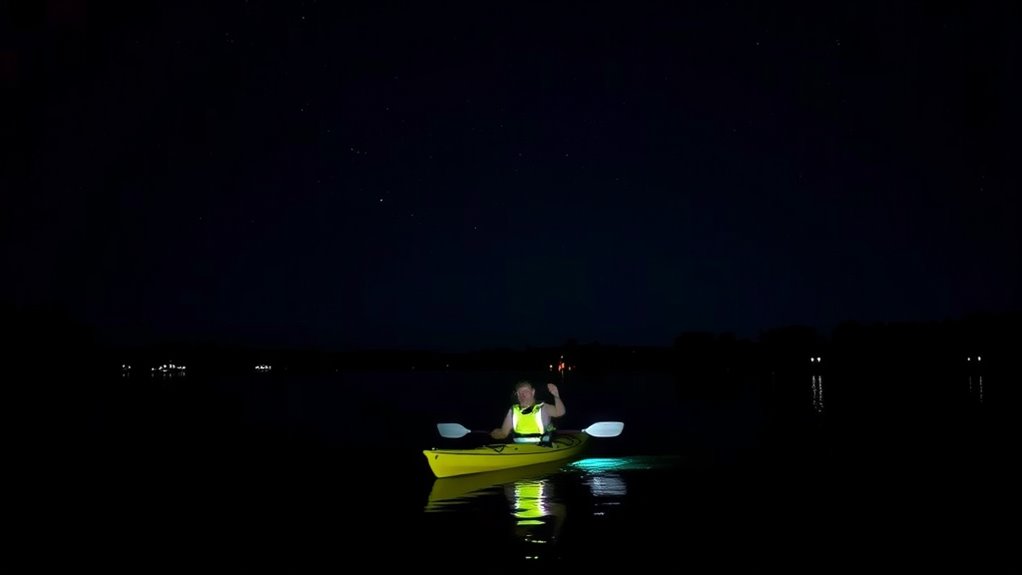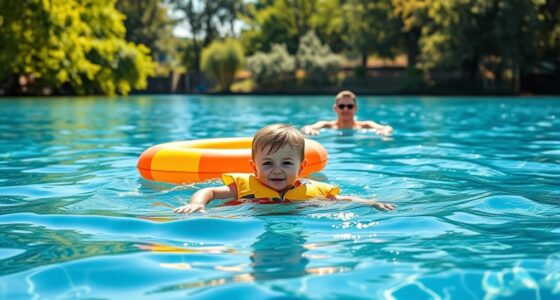When floating after dark, always prioritize safety by ensuring your navigation lights are working and keep them on continuously. Use GPS or traditional compass and maps to stay on course, and familiarize yourself with landmarks beforehand. Maintain a slow speed to react quickly, stay vigilant for other boats or obstacles, and carry waterproof flashlights or headlamps. Communicate your plans and keep emergency devices handy. Following these tips will help you stay safe—continue on to discover more essential safety strategies.
Key Takeaways
- Always ensure navigation lights are functioning and keep them on throughout the float for visibility.
- Use GPS, maps, and landmarks to maintain orientation in low-light conditions.
- Carry waterproof flashlights or headlamps and keep communication devices accessible for emergencies.
- Slow down boat speed to improve reaction time and avoid hazards in reduced visibility.
- Maintain a vigilant lookout for boats, debris, and obstacles, and inform someone of your route and return time.

Floating at night can be a peaceful experience, but it also requires extra caution to stay safe. When you’re out on the water after dark, visibility drops considerably, making it essential to prioritize lighting precautions. Before you set off, ensure your boat is equipped with proper navigation lights that are functioning correctly. These lights not only help you see but also signal your presence to other boaters, reducing the risk of collisions. Keep them on at all times during your float, and double-check they’re working before departure. It’s also wise to carry portable lighting sources, like waterproof flashlights or headlamps, to illuminate your immediate surroundings if needed. Avoid using only your phone’s flashlight, as it can be insufficient and drains your battery quickly. Instead, opt for dedicated boat lighting options that are bright and reliable.
Navigation aids are equally vital when floating at night. Using GPS devices or electronic navigation systems can help you stay on course, especially if you’re unfamiliar with the waterway. Many modern GPS units have night mode features that make screens easier to see without blinding you or other boaters. If electronic aids aren’t available, bring along traditional navigation tools like compasses and detailed maps of the area. Familiarize yourself with key landmarks and waterway markers during daylight hours so you can identify them easily in low light. It’s also a good idea to plan your route in advance, avoiding tricky or shallow areas that could pose hazards in reduced visibility. Always keep a vigilant lookout for other boats, floating debris, or obstacles that might be harder to spot at night. Maintaining a proper lookout means you should have a designated person scanning the water continuously, especially in busy areas. Incorporating visionary quotes about safety and awareness can inspire you to stay cautious and attentive during your nocturnal adventures.
Additionally, communicate your plans with someone on land or onboard who isn’t floating with you. Let them know your route and estimated return time. Carry a whistle or sound-producing device to alert others if you encounter trouble. Stay alert and slow down your boat’s speed to give yourself more reaction time. Remember that in darkness, familiar landmarks may be less visible, so rely on your navigation aids and lighting to maintain awareness of your position. By combining effective lighting precautions with reliable navigation aids, you greatly reduce the risks associated with nocturnal floating. This proactive approach ensures that your experience remains peaceful and enjoyable while keeping safety at the forefront. Always respect water conditions and local regulations to ensure a safe, serene night on the water.
Frequently Asked Questions
Can I Float Alone at Night Safely Without a Guide?
Floating alone at night can be safe if you prioritize solo safety and use proper lighting essentials. Make certain your boat is equipped with waterproof lights and carry a flashlight for visibility. Stay aware of your surroundings, avoid unfamiliar or risky areas, and inform someone about your plans. Trust your instincts, avoid overestimating your skills, and always have a communication device handy. With these precautions, you can enjoy a peaceful night float safely.
What Should I Do if I Get Lost During Nocturnal Floating?
If you get lost during nocturnal floating, stay calm and use your night-time navigation skills. Signal for help with a whistle or flashlight, and try to remember landmarks or your surroundings. Keep emergency preparedness in mind by carrying a waterproof map or a fully charged phone with emergency contacts. Stay close to your float or boat, and avoid panicking—staying composed helps you find your way back safely.
Are There Specific Safety Gear Recommended for After-Dark Floating?
Yes, you should wear reflective clothing to increase visibility and carry a waterproof flashlight to see in low light conditions. These safety gear items help others spot you easily and allow you to navigate safely in the dark. Always check your gear before heading out, and keep your flashlight within reach. Combining reflective clothing with a waterproof flashlight guarantees you stay safe and visible during your nocturnal floating adventure.
How Do I Communicate With Rescue Services if Needed?
If you need to communicate with rescue services, use emergency communication devices like a whistle or waterproof signaling devices to attract attention. Keep a flashlight or glow sticks handy to enhance visibility in the dark. Make sure your phone is charged and stored in a waterproof case. Clearly signal your location with reflective gear or bright clothing, and stay calm while trying to make yourself as visible as possible for rescue teams.
Is Nocturnal Floating Safe for Children or Beginners?
Nocturnal floating isn’t recommended for children or beginners due to safety concerns. You might think it’s safe if supervised, but age restrictions and proper experience are essential. Always make certain kids are accompanied by responsible adults, and only attempt it if you’re confident in your skills. The dark increases risks, so prioritize safety and avoid nocturnal floating until you’re fully prepared and have the necessary supervision in place.
Conclusion
As you venture out after dark, remember these safety tips to stay secure and confident. Keep your senses sharp, stay aware of your surroundings, and trust your instincts—don’t let the night catch you off guard. Think of it as steering through a sea of shadows; with caution, you’ll steer clear of trouble and enjoy the quiet beauty of the night. Stay vigilant, stay safe, and let the darkness be your peaceful companion, not your foe.










